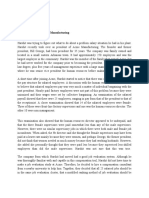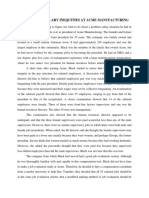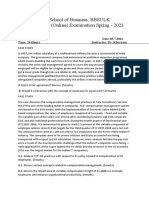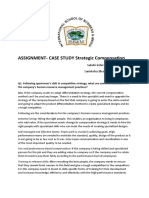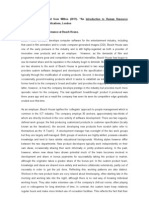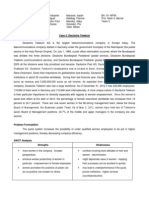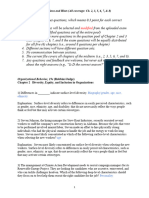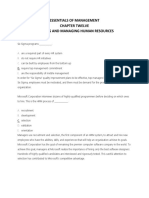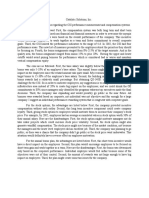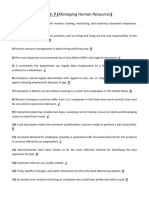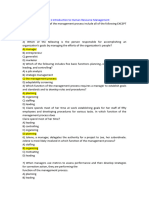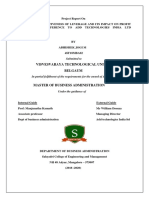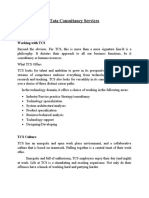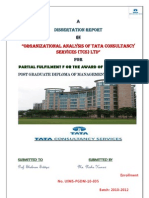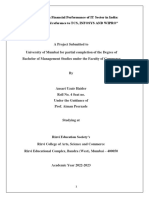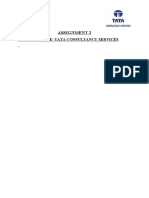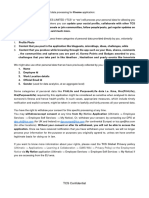ASSIGNMENT ONE
Performance and Compensation Management (CoDE)
1. SALARY INEQUITIES AT PINNACLE MANUFACTURING COMPANY LIMITED
Kwame Tastie was trying to figure out what to do about a problem salary situation he had
in his plant. Tastie recently took over as president of Pinnacle Manufacturing. The founder and
former president, Bill Joe, had been president for 35 years. The company was family owned and
located in a small eastern Arkansas town. It had approximately 250 employees and was the
largest employer in the community. Tastie was a member of the family that owned Pinnacle, but
he had never worked for the company prior to becoming the president. He had an MBA and a
law degree, plus five years of management experience with a large manufacturing organization,
where he was senior vice president for human resources before making his move to Pinnacle.
A short time after joining Pinnacle, Kwame started to notice that there was considerable
inequity in the pay structure for salaried employees. A discussion with the human resources
director led him to believe that salaried employees pay was very much a matter of individual
bargaining with the past president. Hourly paid factory employees were not part of this problem
because they were unionized and their wages were set by collective bargaining. An examination
of the salaried payroll showed that there were 25 employees, ranging in pay from that of the
president to that of the receptionist. A closer examination showed that 14 of the salaried
employees were female. Three of these were front-line factory supervisors and one was the
human resources director. The other 10 were non-management.
This examination also showed that the human resources director appeared to be
underpaid, and that the three female supervisors were paid somewhat less than any of the male
supervisors. However, there were no similar supervisory jobs in which there were both male and
female job incumbents. When asked, the HR director said she thought the female supervisors
may have been paid at a lower rate mainly because they were women, and perhaps Joe, the
former president, did not think that women needed as much money because they had working
husbands. However, she added she personally thought that they were paid less because they
supervised less-skilled employees than did the male supervisors. Tastie was not sure that this was
true.
The company from which Tastie had moved had a good job evaluation system. Although
he was thoroughly familiar with and capable in this compensation tool, Tastie did not have time
to make a job evaluation study at Pinnacle. Therefore, he decided to hire a compensation
consultant from a nearby university to help him. Together, they decided that all 25 salaried jobs
should be in the same job evaluation cluster, that a modified ranking method of job evaluation
should be used, and that the job descriptions recently completed by the HR director were current,
accurate, and usable in the study.
� The job evaluation showed that the HR director and the three female supervisors were
being underpaid relative to comparable male salaried employees. Tastie was not sure of what to
do. He knew that if the underpaid female supervisors took the case to the local EEOC office, the
company could be found guilty of sex discrimination and then have to pay considerable back
wages. He was afraid that if he gave these women an immediate salary increase large enough to
bring them up to where they should be, the male supervisors would be upset and the female
supervisors might comprehend the total situation and want back pay. The HR director told Tastie
that the female supervisors had never complained about pay differences.
The HR director agreed to take a sizable salary increase with no back pay, so this part of
the problem was solved. Tastie believed he had four choices relative to the female supervisors:
1. To do nothing.
2. To gradually increase the female supervisors salaries.
3. To increase their salaries immediately.
4. To call the three supervisors into his office, discuss the situation with them, and
jointly decide what to do.
YOU ARE REQUIRED TO ANSWER THE FOLLOWING QUESTIONS:
(a) As a performance and compensation management student, how do you think Pinnacle
Manufacturing got into a situation like this in the first place? (4 Marks)
(b) Do the pay inequity situation have any legal implication on the company? Explain your
answer. (3 Marks)
(c) Suggest any two pay systems or plans Tastie can adopt in order to ensure that there is
fairness among the male and female supervisors in Pinnacle. (4 Marks)
(d) What do you think the female supervisors doing comparable jobs with the male
supervisors will do upon perceiving inequity in their pay? (3
Marks)
(e) Identify any two consequences that the inequity in salaries can have on companies like
Pinnacle. (3 Marks)
(f) Which of the four choices relative to the female supervisors would you advise Tastie to
adopt and why? (3 Marks)
� ASSIGNMENT TWO
Performance and Compensation Management (CoDE)
2. PERFORMANCE MANAGEMENT AND REWARDS AT TATA CONSULTANCY
SERVICES
Established in 1968 as Tata Computer Centre, Tata Consultancy Services (TCS) is a pioneer in
the IT arena in India. Headquartered in Mumbai, Maharashtra, it is an Indian multinational and
operates in 46 countries. It is the world’s 2nd-largest IT services provider. TCS is one of the
largest Indian companies by market capitalization. It is among the most valuable IT services
brands worldwide. TCS alone generates 70 percent dividends of its parent company, Tata Sons.
In 2015, TCS was ranked 64th in the Forbes World’s Most Innovative Companies ranking. In
2017, it was ranked 10th on the Fortune India 500 list. In April 2018, TCS became the first
Indian IT company to cross $100 billion market capitalization. Its focus on building a diverse
workforce along with a supportive work environment has contributed to its immense popularity.
As part of the business mandate to become more responsive, TCS announced at the beginning of
2018 that it is adopting enterprise-wide Agile, a new delivery model that is focused on delivering
outsourcing projects in increments within a well-defined short duration. This necessitated
overhauling its HR strategy. The move was intended to support the new shorter and quicker
delivery model demanded by clients today.
Agile systems are typically comprised of smaller teams who work on a finite set of clearly
defined items. The teams’ goals and composition change as the project evolves. It is like a fleet
of small but powerful motorboats steering more efficiently than a giant ship. Becoming agile has
implications for core processes like HR. One significant impact of building agile systems was on
the performance appraisal mechanism at TCS. Agile philosophy is changing the way TCS
measures the performance of its employees, manages talent development, and budgets for
recruitment. Previously, workforce planning, budgeting, and goal-setting were easier to do as IT
projects were longer and more predictable in nature. Scrapping the bell curve model, TCS set
about redesigning its appraisal system. The bell curve system of performance appraisal is a
forced ranking system. Through this system, the organization tries to segregate the best,
mediocre, and worst performers nurture the best, and discard the worst. This segregation is based
on a relative comparison of the performance of the workforce against those engaged in similar
activity and ranking them accordingly. TCS has decided to give up this model for a more agile
system. Its appraisal system will be redesigned from scratch.
To build a flawless model, the company would be assessing its employees on a more regular
basis, instead of periodic appraisal. The appraisal system will be separate for IT and BPO
employees. TCS announced that the company will modify an existing platform for its IT
appraisals, while for the BPO employees it would be more of a social media system. Along with
that, appraisal of senior executives is also being closely examined. This new system was planned
�to be implemented in a stage-wise manner covering one sub-set of employees at a time.
Gradually, the company would be ready to move towards continuous appraisal and feedback
cycle round the year applicable for all employees. Instead of half-yearly appraisal system,
targeted employees would move to a project end appraisal cycle—and that the projects could last
anywhere from two months to a year. It is a more continuous feedback system. The entire
workforce is being trained in Agile methodology.
TCS is also changing the way it budgets for workforce planning by involving business heads and
being continuously flexible about hiring budgets. The company is gearing to get the business
fully involved in the workforce planning side, so that it does not end up hiring the kind of
competencies they may not need for a long time. Learning and development is another major
area that is going through change. The company is moving certain people from business
functions to talent development so they can bring in the right expertise. There is cross functional
movement to nurture expertise and promote learning. There is a need to have continuous
upgradation of competencies. Employees need to reinvent themselves continuously, with
relearning and new skill sets. The new performance management strategy is synchronized to
support continuous learning and improvement. This also calls for an overhaul of its reward
strategy to match with the new performance appraisal agenda. Both monetary and non-monetary
rewards have always been part of the total rewards strategy at TCS.
The company has been quite inventive in the past in terms of pioneering new reward systems
such as work-from-home and flexible timings as part of its non-monetary incentives. The new
‘agile’ philosophy may require further reinventing its rewards game plan. However, the new
system is likely to face many challenges. The total employee count at TCS at the end of
December 2017 stood at 390,880, making it the biggest IT firm by employee strength. It involves
addressing key concerns such as: How will the new system apply to all employees? How to
measure people as they are doing small projects? How will accountability get fixed? And so on.
The company feels that the younger workforce is more aware of the way it works and is, thus,
more receptive to the new system. The challenge is for mid- to senior-level employees to also
appreciate this process because they are accustomed to doing things in a specific way. Changing
their mindset will require time. IT service companies in India as well as across the globe will
keenly watch how TCS manages its appraisal system, given the scale of the exercise. TCS is
looking forward to adopting a system of continuous feedback and performance improvements, a
goal that may be hard to achieve, given its sheer size and number of employees.
YOU ARE REQUIRED TO ANSWER THE FOLLOWING QUESTIONS:
(a) Discuss the key features of the new business model at TCS. What are its HR
implications? (10
Marks)
�(b) What are the challenges that TCS is likely to face vis-à-vis its new performance
management and reward strategy? Suggest ways to overcome the initial hurdles.
(10
Marks)
Please the following are Key Instructions to note:
This is an individual assignment. Hence, independent work is highly
encouraged because write-ups that are too identical will be cancelled.
You must understand the case and summarize it before you start answering the
questions that follow.
Use a word processor - font Times New Roman and font size 12 for this
assignment and preferably one and a half line spacing should be used. The work
should be neatly bind.
Proofread all written work for typographical and grammatical errors. All written
assignments should be properly referenced in APA format.
Each assignment should not be less than 6 pages and more than 10 pages.
Date for submission is on or before Monday, 22nd April, 2024 before the close of
work. Any assignment submitted after the due date will not be accepted.
Please note that, all assignments should be given to the course representatives who
will duly submit it on the due date.
This assignment is hereby sent to the course rep. via email today, Sunday 7th
April, 2024.
Thank you.

